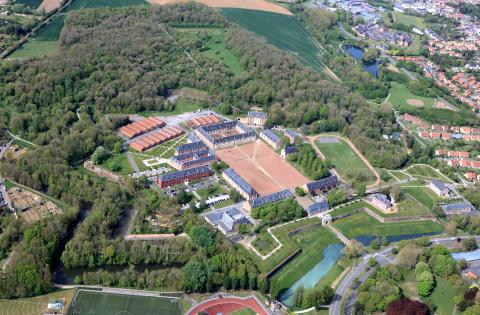Vauban’s great talent lies in optimizing bastioned fortifications, the defence system introduced and developed by first Italian and then Dutch engineers from the 16th century onwards. As opposed to medieval defence systems made up of high, thick walls, it is a system which drives defensive works into the ground thus rendering them less fragile.
Vauban used what already existed to complete the natural defences of towns and strategic communication routes: namely, he used the morphology of the terrain, the ground’s resources and the earth’s layers. He considered that the Alps, the Pyrenees and the Atlantic coast were natural obstacles which protected the country. Only one part of the territory was directly exposed, that of the vast Flanders plain where strongholds regularly changed hand during attacks. To protect this zone he suggested creating his "Pre carré" made up of a double line of fortified towns to protect the north-east border against the Spanish Netherlands.
To command towns, he built citadels on the urban wall, as at Arras, Besançon and Saint-Martin-de-Ré. Where no town existed he sometimes built one from scratch. Of the nine new towns that he built, four are still practically intact today, namely Longwy, Mont-Louis, Mont-Dauphin and Neuf-Brisach.
To defend the coasts, he developed several types of towers equipped with canons to watch over the open sea. Fort Pâté in the centre of the Gironde estuary is the most compact example. The Gilded Tower at Camaret sur Mer has a low battery to defend the entrance to the Brest harbour. Those at Tatihou and the Hougue in the Cotentin, planned to repel English attacks, are on the other hand equipped with canons on a terrasse about 25 metres above the ground. The bastioned tower, as in Besançon where several of the first examples are still preserved, illustrates that the tower was also useful far from the sea. In fact, this is Vauban’s answer for a narrow stretch of land where it was not possible to build a classic bastioned wall.
For both strategic and economic reasons, Vauban integrated strongholds that had often existed since the Middle Ages, into his fortification projects and adapted them. This was the case in Villefranche-de-Conflent and the Blaye citadel. We can also appreciate his sensibility to the conditions of the terrain through construction techniques used, notably to build Forts Pâté and Médoc located on marshland. Vauban strove to rationalize the fortifications that he conceived, but at times the geographical location of the site forced him to abandon all principles of standardization. Briançon in the Hautes Alpes is probably the best example.
Throughout the diversity of his work, Vauban succeeded in setting the standards for a certain number of buildings. He created models for different military buildings such as gates, corps de garde in front of the gates to guard the comings and goings to the fortress, powder magazines and barracks with the specific purpose of housing the troops who up until then had been accommodated with local residents.. However he built works according to local customs in each territory, giving top priority to the shape, and to the use of locally-sourced building materials.
Vauban considered each project to be unique, as it was mutually dependent on its context, and refused to write the fortification treaty requested by the king. His fortifications present a sober but sure aesthetic quality, which can be seen in the importance of the works and in their splendour, or at times in a provocative artistic expression such as on the pediments of the gates turned towards the enemy, embossed with the arms of the Sun King.

